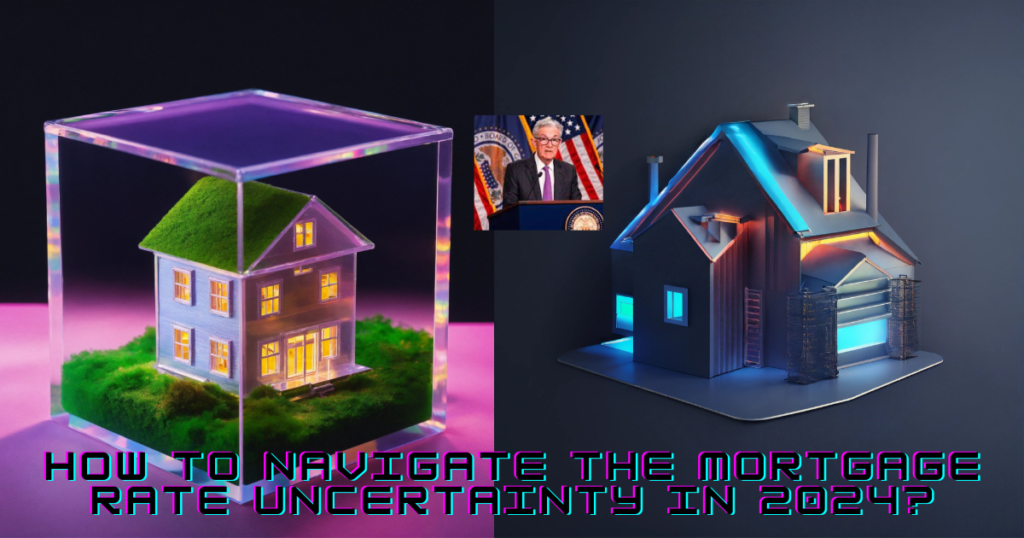Introduction:
As we step into the complex realm of real estate, mortgage rates emerge as silent architects, intricately shaping the dynamics of housing demand and supply. Their influence is not confined to mere affordability; it permeates through the very fabric of buying and selling homes. In this exploration, we aim to dissect the multitude of factors that mold mortgage rate Uncertainty. These predictions act as a guiding star, steering the course of the housing market amidst the ebb and flow of economic tides.

The Multitude of Factors that Mold Mortgage Rate Uncertainty
- 1. The Federal Reserve’s Monetary Policy: The Maestro's Baton
- 2. The Inflation Rate: The Economic Seesaw-Mortgage Rate Uncertainty
- 3. Economic Growth: The Pulse of Prosperity
- 4. Housing Supply: The Quandary of Quantity-Mortgage Rate Uncertainty
- 5. Housing Demand: The Siren Song-Mortgage Rate Uncertainty
- 6. Consumer Confidence: The Market's Emotional Barometer
- 7. Credit Score: The Financial Symphony-Mortgage Rate Uncertainty
- 8. Mortgage Type: The Choices We Make-Mortgage Rate Uncertainty
- 9. Loan-to-Value Ratio: Balancing Act of Borrowing
- 10. Debt-to-Income Ratio: The Financial Compass
- 11. Mortgage Term: The Time Horizon
- 12. Mortgage Points: The Price of Precision-Mortgage Rate Uncertainty
- 13. Mortgage Market: The Labyrinth of Exchange
- 14. Global Events: The Unpredictable Symphony
- 15. Consumer Behavior: The Human Element
- Conclusion: Decoding the Symphony of Predictions
- FAQs: People also ask
- Disclaimer
1. The Federal Reserve’s Monetary Policy: The Maestro’s Baton
At the core of the intricate dance of mortgage rates is the Federal Reserve, the conductor of the economic orchestra. The federal funds rate, under the Fed’s purview, orchestrates short-term and long-term interest rates, thus shaping mortgage rate predictions. Understanding this intricate ballet requires us to delve into how the Federal Reserve’s decisions ripple through the housing market.
Illustration: Consider 2024 when the Fed decided to keep the federal funds rate unchanged but hinted at future rate cuts. This nuanced announcement had a harmonious impact, causing mortgage rate predictions to gracefully descend as the market anticipated a future of lower interest rates.
2. The Inflation Rate: The Economic Seesaw-Mortgage Rate Uncertainty
Inflation, the economic seesaw, has a profound impact on mortgage rate predictions. A tug-of-war between too much and too little inflation influences the market’s expectation of future interest rates. Understanding how inflation plays this pivotal role allows us to foresee the undulating landscape of mortgage rate predictions.
Illustration: The inflation rate surged to 6.8% in 2023 due to various factors like supply chain disruptions and labor shortages triggered by the COVID-19 pandemic. This surge prompted the market to anticipate the Fed’s response, with predictions of higher mortgage rates in anticipation of measures to combat inflation.
3. Economic Growth: The Pulse of Prosperity
Economic growth, akin to the heartbeat of a nation, echoes through the corridors of mortgage rate predictions. A robust economy fuels the demand for money and credit, thereby influencing upward predictions. Conversely, a stagnant economy might usher in predictions of lower rates, mirroring a subdued demand for mortgages. Mortgage Rate Uncertainty
Illustration: In 2023, the U.S. witnessed a robust 5.7% economic growth, rebounding from the contraction caused by the COVID-19 pandemic. This surge in economic activity contributed to heightened mortgage rate predictions as the market brimmed with optimism and increased demand for mortgages.
4. Housing Supply: The Quandary of Quantity-Mortgage Rate Uncertainty
The housing supply, a pendulum between abundance and scarcity, directly influences mortgage rate predictions. Understanding the delicate balance between the number of homes available and the preferences of potential buyers is key to decoding how supply dynamics shape predictions.
Illustration: 2023 witnessed a record low housing supply in the U.S. – 1.25 million units, a 2.6-month supply at the current sales pace. This scarcity triggered lower mortgage rate predictions as the market grappled with decreased demand and increased pessimism. Mortgage Rate Uncertainty

5. Housing Demand: The Siren Song-Mortgage Rate Uncertainty
The allure of homeownership, encapsulated in housing demand, creates ripples in the mortgage market. Understanding the factors that drive demand and how they translate into predictions is vital for comprehending the melody that shapes the market’s expectations.
Illustration: In 2023, robust housing demand in the U.S. stemmed from low mortgage rates, a surge in household formation, the millennial generation entering prime home-buying age, and increased preference for homeownership post the COVID-19 pandemic. This surge in demand elevated mortgage rate predictions, reflecting optimism in the market. Mortgage Rate Uncertainty
6. Consumer Confidence: The Market’s Emotional Barometer
Consumer confidence acts as the emotional compass of the market, influencing mortgage rate predictions. High consumer confidence translates into positive market expectations, whereas a decline in confidence may lead to lowered predictions, anticipating reduced market vigor.
Illustration: In 2023, an improvement in consumer confidence in the U.S., reaching a 17-month high, was aligned with increased demand and optimistic mortgage rate predictions. This uptick was driven by progress in COVID-19 vaccinations, economic reopening, and labor market recovery.
7. Credit Score: The Financial Symphony-Mortgage Rate Uncertainty
Credit scores play a crucial role in the mortgage symphony, influencing the availability and cost of credit for borrowers. Understanding how credit scores sway mortgage rate predictions allows for a deeper comprehension of the financial symphony that echoes through the housing market.
Illustration: The average credit score in the U.S. reached a record high of 716 in 2023, driven by stimuli, forbearance programs, and reduced spending during the COVID-19 pandemic. This surge in creditworthiness led to heightened mortgage rate predictions, reflecting increased demand and confidence in the market.
8. Mortgage Type: The Choices We Make-Mortgage Rate Uncertainty
The diverse landscape of mortgage types adds a unique harmony to mortgage rate predictions. Understanding the risk and return associated with various mortgage types allows us to decipher how borrower and lender choices shape the symphony of predictions.
Illustration: In 2023, the average interest rate for a 30-year fixed-rate mortgage was 3.11%, while a 5/1 adjustable-rate mortgage carried an average interest rate of 2.79%. The stability of the fixed-rate mortgage resulted in higher predictions compared to the more flexible but riskier adjustable-rate mortgage.
9. Loan-to-Value Ratio: Balancing Act of Borrowing
The Loan-to-Value Ratio (LTV) orchestrates a delicate dance, determining the equity or down payment a borrower has. This ratio, a barometer of risk, influences mortgage rate predictions by balancing the scales between higher and lower-risk mortgages.
Illustration: In 2023, a conventional mortgage with an average LTV of 80% contrasted with an FHA mortgage with a 96% LTV. The conservative nature of the conventional mortgage, requiring a higher down payment, resulted in lower mortgage rate predictions compared to the riskier FHA mortgage.
10. Debt-to-Income Ratio: The Financial Compass
The Debt-to-Income Ratio (DTI) acts as a financial compass, guiding mortgage rate predictions by indicating the borrower’s ability to manage debt. Understanding how this ratio impacts risk and return allows for a nuanced comprehension of mortgage rate dynamics. Mortgage Rate Uncertainty
Illustration: In 2023, a conventional mortgage with an average DTI of 36% differed from an FHA mortgage with a 43% DTI. The lower-risk conventional mortgage predicted lower rates compared to the FHA mortgage, reflecting the market’s perception of varying risks and returns.
11. Mortgage Term: The Time Horizon
The duration of a mortgage, encapsulated in the Mortgage Term, holds a pivotal role in shaping predictions. Whether opting for a shorter or longer term, borrowers and lenders influence mortgage rate predictions through the prism of risk and return associated with the time horizon. Mortgage Rate Uncertainty
Illustration: In 2023, the average interest rate for a 30-year mortgage stood at 3.11%, while a 15-year mortgage carried an average interest rate of 2.38%. The allure of a longer repayment period for the 30-year mortgage resulted in higher predictions compared to the shorter-term 15-year mortgage.

12. Mortgage Points: The Price of Precision-Mortgage Rate Uncertainty
Mortgage Points, akin to paying for precision, allow borrowers to lower their interest rates. Understanding how this delicate trade-off between upfront payment and ongoing costs influences mortgage rate predictions unravels the intricacies of borrower and lender decisions.
Illustration: In 2023, a 30-year mortgage averaged 0.7 mortgage points, while a 15-year mortgage had 0.6 points. The lower upfront payment and higher interest rate of the 30-year mortgage resulted in lower mortgage rate predictions compared to the 15-year mortgage.
13. Mortgage Market: The Labyrinth of Exchange
The Mortgage Market, a labyrinth where borrowers and lenders engage, plays a pivotal role in shaping predictions. Understanding the dynamics between the primary and secondary markets illuminates how the efficiency and liquidity of this intricate exchange impact mortgage rate predictions.
Illustration: In 2023, a well-functioning mortgage market, facilitated by low rates, high housing demand, economic recovery, and supportive government policies, led to stable and consistent mortgage rate predictions, reflecting market equilibrium and confidence. Mortgage Rate Uncertainty
14. Global Events: The Unpredictable Symphony
Global events, the unpredictable symphony playing on the world stage, cast shadows on mortgage rate predictions. From political shifts to natural disasters, understanding how these global nuances impact the uncertainty and risk in the market allows for a comprehensive grasp of the forces at play. Mortgage Rate Uncertainty
Illustration: The mixed global events of 2023, including positive occurrences like successful vaccine rollouts and negative events like geopolitical tensions and natural disasters, led to fluctuating mortgage rate predictions. The market, in response to these global uncertainties, experienced moments of both stability and volatility.
15. Consumer Behavior: The Human Element
Consumer behavior, the human element in the mortgage market equation, adds an extra layer of unpredictability. In 2023, consumer behavior, influenced by a myriad of factors, showcased a paradoxical dance between opportunities and threats, shaping unpredictable mortgage rate predictions.
Illustration: In the face of both opportunities, such as low mortgage rates and a robust economic recovery, and threats, like high inflation and low housing supply, consumer behavior in 2023 acted in contradictory ways. This led to an erratic market, with mortgage rate predictions failing to accurately capture the diverse and sometimes conflicting actions of consumers.
Conclusion: Decoding the Symphony of Predictions
In the symphony of mortgage rate predictions, each instrument plays a crucial role. From the conductor, Federal Reserve, orchestrating macroeconomic movements, to the individual notes struck by consumer behavior, every element contributes to the melody of predictions. Recognizing these intricate dynamics allows homebuyers and sellers to navigate the housing market with informed precision. As the market continues its dance, understanding these factors provides a compass for strategic decision-making in the ever-evolving landscape of mortgage rate predictions.
FAQs: People also ask
- What is the prediction for mortgage rates?
- Mortgage rate predictions are influenced by various factors such as economic indicators, Federal Reserve policies, and market conditions. Accurately predicting exact rates is challenging, but factors like inflation rates, economic growth, and central bank policies play a crucial role.
- Will home loan interest rates go down in 2024 in the US?
- Predicting specific movements in interest rates involves uncertainties, but factors like Federal Reserve actions and economic conditions can provide insights. Monitoring announcements from the Federal Reserve and staying informed about economic trends can offer indications of potential rate changes.
- How do banks set mortgage rates?
- Banks set mortgage rates based on a combination of factors. The prime rate, set by the Federal Reserve, influences short-term rates. Banks also consider the borrower’s credit score, loan-to-value ratio, and prevailing market conditions. Additionally, the type of mortgage and prevailing economic indicators contribute to the determination of individual mortgage rates.
More FAQs
- Will mortgage rates go down in 2024 Canada?
- Predicting specific movements in mortgage rates involves uncertainties, and factors like economic conditions, inflation rates, and central bank policies influence rate changes. Monitoring these factors and staying updated on financial news can provide insights into potential trends.
- How much will my mortgage go up if interest rates rise?
- The impact of rising interest rates on your mortgage depends on various factors, including the loan amount, interest rate changes, and the remaining term of your mortgage. Utilizing online mortgage calculators or consulting with a financial advisor can help estimate the potential impact on your specific mortgage.
- Can you negotiate mortgage rates?
- Yes, negotiating mortgage rates is possible. Borrowers can engage with lenders to discuss and potentially negotiate interest rates, especially if they have a strong credit history. Shopping around for different lenders and mortgage products can also provide leverage in negotiating more favorable rates and terms.
Disclaimer
This article has been created on the basis of internal data, information available publicly, and other reliable sources to be believed. The article may also include information which are the personal views/opinions of the authors. The information included in this article is for general, educational, and awareness purposes only and is not a full disclosure of every material fact.
All the information on this website i.e. World Virtual CFO – is published in good faith and for general information purposes only. World Virtual CFO does not make any warranties about the completeness, reliability, and accuracy of this information. These are my views for only information purposes. Any action you take upon the information you find on this website (World Virtual CFO), is strictly at your own risk. World Virtual CFO will not be liable for any losses and/or damages in connection with using our website. For details please refer to our disclaimer page.